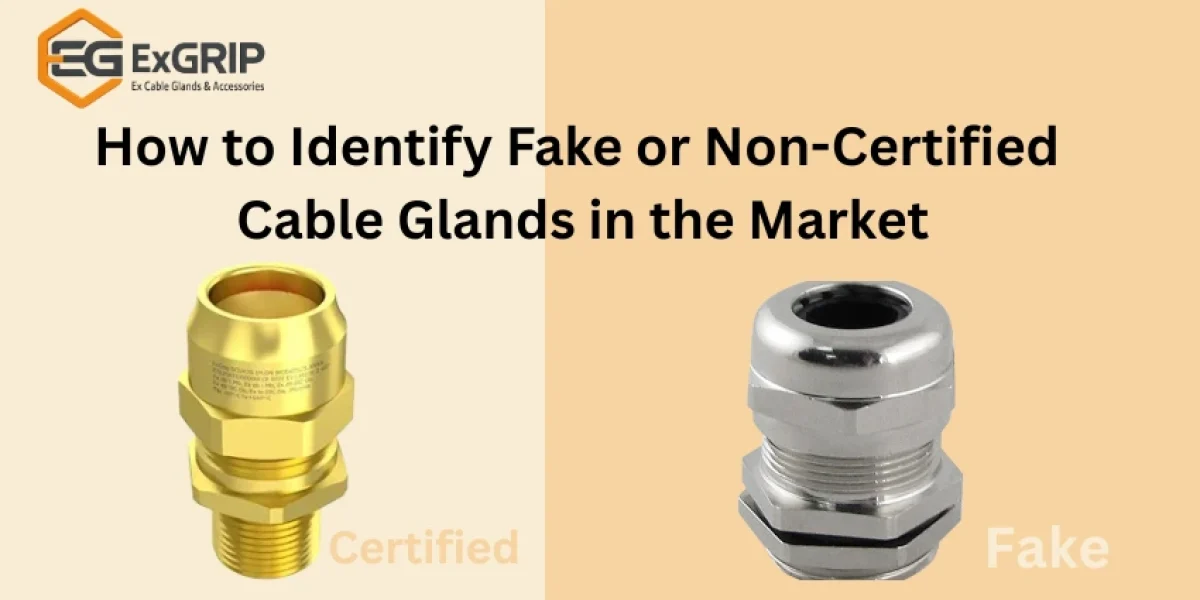In today’s fast-growing electrical and industrial market, fake or non-certified cable glands are becoming a serious problem. Many suppliers sell low-cost, imitation products that look similar to genuine ones but they lack the essential safety certifications such as ATEX, IECEx, and IP ratings.
These counterfeit cable glands may seem affordable, but they can lead to short circuits, equipment damage, or even explosions in hazardous areas.
If you’re using brass cable glands, waterproof cable glands, or industrial cable gland connectors, understanding how to identify real vs. fake ones can save both lives and assets.
Why Certified Cable Glands Matter
Certified cable glands are more than just connection fittings they’re a vital part of ensuring electrical and industrial safety. Every genuine cable gland undergoes strict testing for sealing, conductivity, mechanical strength, and flameproof protection.
When you use a non-certified or fake cable gland, you’re risking:
Electrical failures caused by poor sealing or weak metal quality.
Ingress of dust or moisture that can lead to corrosion or short circuits.
Loss of certification compliance for your equipment or entire project.
Increased maintenance and replacement costs due to early product failure.
On the other hand, a certified cable gland comes with proof of testing – like ATEX, IECEx, or IP66/IP68 ratings – ensuring it can withstand extreme environments, from offshore platforms to automation systems.
In short, certified brass cable glands, waterproof cable glands, and cable gland connectors are built to perform reliably and protect your system from hazards.
Common Signs of Fake Cable Glands in the Market
Counterfeit cable glands are often cleverly made, but subtle differences reveal their poor quality. Here’s how to identify them:
Missing or Fake Certification Markings
Authentic products have clear ATEX, IECEx, or IP marking along with the manufacturer’s name and batch number.
Fake products often miss these or display unclear laser-etched logos with spelling errors or inconsistent formatting.
Poor Material Quality
Genuine brass cable glands have a solid, polished finish, while fake ones feel light, uneven, or roughly cast.
Low-quality metal may corrode faster, especially in marine or outdoor environments.
No Documentation or Test Certificates
Every certified cable gland must come with a Declaration of Conformity (DoC) and a test certificate.
If the supplier avoids sharing these documents, it’s a red flag.
Suspiciously Low Pricing
If the price seems too good to be true – it probably is. Non-certified or duplicate products often enter the market at 30–50% lower rates than genuine certified glands.
Unbranded or Generic Packaging
Authentic manufacturers like Exgrip use branded packaging with serial numbers and QR codes.
Fake ones usually come in plain boxes, missing barcodes or holographic seals.
Certifications That Prove Authenticity
| Certification | Purpose | Common Application |
|---|---|---|
| ATEX / IECEx | Explosion-proof safety | Oil & Gas, Chemical, Refineries |
| IP66 / IP68 | Waterproof and dust-tight protection | Outdoor and marine installations |
| RoHS / REACH | Environmental and material safety | General electrical manufacturing |
| UL / CSA | North American safety compliance | Export projects |
A certified waterproof cable gland or brass cable gland connector should always list these marks on the body or product datasheet.
How to Verify if a Cable Gland is Genuine
Check the Manufacturer’s Website
Visit the brand’s official website (like Exgrip.com) and verify if the model and serial number match.Ask for Test Certificates
Always request ATEX, IECEx, or IP certification documents before purchase.Buy Only from Authorized Distributors
Purchase from verified dealers or directly from manufacturers to avoid counterfeit risk.Inspect Product Details Closely
Look for spelling mistakes, mismatched fonts, or poorly etched certification codes.Compare the Weight and Finish
Real brass cable glands have consistent weight, shine, and threading fake ones often don’t.
The Risk of Using Non-Certified Cable Glands
Using non-certified or fake cable glands can have severe consequences:
Compromised explosion safety in hazardous areas
Loss of warranty or insurance coverage
Costly downtime and repairs
Legal penalties for using non-compliant components
In industries like oil & gas, renewable energy, marine, and automation, every connection matters. A fake gland isn’t just a cost risk — it’s a safety hazard.
Why Exgrip Only Supplies Certified Cable Glands
At Exgrip, we’re committed to providing genuine, certified, and globally compliant cable glands that meet all international safety standards.
From brass cable glands and waterproof cable glands to reducers, adapters, and stopping plugs, every product we make is tested for durability, precision, and compliance.
Our in-house R&D team, led by IECEx CoPC-certified experts, ensures that each cable gland is traceable, documented, and ready for global use with certifications like ATEX, IECEx, and IP68.
Choosing Exgrip means choosing long-term reliability and global trust.
Conclusion & Call-to-Action
Fake and non-certified cable glands may seem cheaper at first, but they pose long-term risks that can cost thousands in maintenance, safety violations, or even accidents.
Always verify your supplier, inspect markings, and ask for certificates before installation.
Remember the right cable gland connector not only seals your cable but protects your entire system.
Looking for genuine certified cable glands for your project?
📩 Talk to our technical team today at Exgrip.com
📞 Or call us directly for quick assistance!
Contact Us:
📞 Phone: +91 9537118899
🌐 Website: www.exgrip.com
📩 Request a Quote: Contact Page
FAQs
Q1. What is a fake cable gland?
A fake cable gland is an imitation product without genuine certification or testing, often made from poor-quality materials that compromise safety.
Q2. How can I check if my cable gland is certified?
Look for clear markings like ATEX, IECEx, or IP ratings and verify them with the manufacturer’s certificate or website.
Q3. Why are non-certified cable glands risky?
They may fail under pressure, allow moisture or dust inside, and invalidate system compliance in industrial environments.
Q4. What certifications should a genuine cable gland have?
Look for ATEX, IECEx, IP66/IP68, RoHS, and REACH compliance.
Q5. Does Exgrip provide certified cable glands?
Yes, all Exgrip products are certified, tested, and globally approved for industrial and hazardous zone applications.

